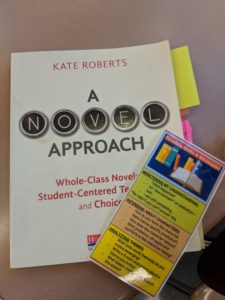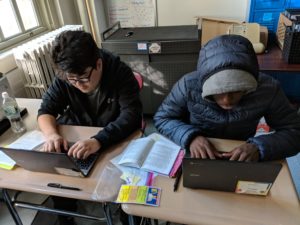 In our co-taught 9th & 10th grade literature classroom, Caitlin and I are currently living by the motto, “teach the reader, not the book”. While we are thrilled when our students understand and enjoy a book, we are also deeply committed to ensuring that we are teaching them critical thinking and reading skills that are transferrable and will allow them to be successful with any book they read. This semester we are engaging in this work by using Kate Roberts’ book, A Novel Approach: Whole-Class Novels, Student-Centered Teaching, and Choice as a teacher-mentor text. Roberts’ book has helped guide us in creating a framework for reading a whole-class novel in a more authentic, student-centered, and practical way. We approached the semester with the problem of practice, “How might we teach the reader, rather than the book?” This means pushing away the tendencies to fall into “traditional literature classroom traps” such as: Getting caught up in long (and often disengaging) whole-class readings aloud, discussions where only a few students truly participate and feeding students what is most import to take from a text.
In our co-taught 9th & 10th grade literature classroom, Caitlin and I are currently living by the motto, “teach the reader, not the book”. While we are thrilled when our students understand and enjoy a book, we are also deeply committed to ensuring that we are teaching them critical thinking and reading skills that are transferrable and will allow them to be successful with any book they read. This semester we are engaging in this work by using Kate Roberts’ book, A Novel Approach: Whole-Class Novels, Student-Centered Teaching, and Choice as a teacher-mentor text. Roberts’ book has helped guide us in creating a framework for reading a whole-class novel in a more authentic, student-centered, and practical way. We approached the semester with the problem of practice, “How might we teach the reader, rather than the book?” This means pushing away the tendencies to fall into “traditional literature classroom traps” such as: Getting caught up in long (and often disengaging) whole-class readings aloud, discussions where only a few students truly participate and feeding students what is most import to take from a text.
To accomplish this, we have created and been using a teacher generated bookmark (inspired by Kate Roberts) to help guide our students in making authentic, thoughtful annotations as they read. The students are asked to frequently discuss and identity their annotations as either being an example of monitoring their understanding, making an inference, or analyzing themes. We have been more intentional in explicitly teaching these skills by providing them with strategies (in the form of questions also found on the bookmark) that help guide them towards doing this higher order thinking. We also have started pushing students to step outside of their “monitoring for understanding” comfort zones and encouraged them to be more purposeful in trying to rely more heavily on making inferences and noticing themes, since these are skills that will transfer effectively to any text they are trying to read and understand.
Lastly, students are rewarded for their deep thinking and consistent annotating through what we call “weekly long-writes” (also an adapted routine from Kate Roberts). Students have the opportunity to pick a post it note that they authentically created, and they then create 2-3 follow up questions that will guide them in creating their own, unique analysis of the moment they have selected. The long-writes allow students to engage in sustained, independent writing in a supportive environment (and with appropriate scaffolds and modifications). Meanwhile, the long-writes have become an invaluable tool of assessment for us, as we can gauge our students’ progress and thinking over the course of several weeks.
We believe that the differentiation inherent in the bookmark as a tool, helps all students “play the game” of reading. While some students are able to c consistently make more sophisticated inferences and analytical noticings with the help of this tool, other students still grapple with making meaning of what they are reading. We embrace this challenge, because as long as every student is engaged in thinking at a level that appropriately pushes them, we believe the students are being authentically engaged in the discipline of English.
consistently make more sophisticated inferences and analytical noticings with the help of this tool, other students still grapple with making meaning of what they are reading. We embrace this challenge, because as long as every student is engaged in thinking at a level that appropriately pushes them, we believe the students are being authentically engaged in the discipline of English.

I am not sure if this is something you can use at all but recently I have been working on trying to get students to talk more analytically about texts. After reading the text, I have students sit in groups of 3-4 and with a list of talking prompts. I scaffold the prompts so all students can feel comfortable using one. I do ask a student to record the conversation on their voice memo on their cell phones during class. Students will discuss and email the group the conversation. The homework for the night is to listen to the recording and write down a question and 2-3 new understandings of the text. The next day I have students on a google doc, answer the EQ and some other questions related to content or text in what I call a silent seminar. It is amazing the conversations students have when they are silently conversing. This becomes a living document of summative and analytical thinking students can refer to when writing projects.